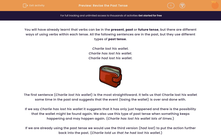You will have already learnt that verbs can be in the present, past or future tense, but there are different ways of using verbs within each tense.
All the following sentences are in the past, but they use different types of the past tense.
Charlie lost his wallet.
Charlie has lost his wallet.
Charlie had lost his wallet.

The first sentence (Charlie lost his wallet) is the most straightforward. It tells us that Charlie lost his wallet some time in the past and suggests that the event (losing the wallet) is over and done with. This is the simple past tense.
If we say Charlie has lost his wallet it suggests that it has only just happened and there is the possibility that the wallet might be found again. We also use this type of past tense when something keeps happening and may happen again. (Charlie has lost his wallet lots of times.) This is the present perfect tense.
If we are already using the past tense, we would use the third version (had lost) to put the action further back into the past. (Charlie told us that he had lost his wallet.) This is the past perfect.
In this activity, we will practise choosing the most suitable version of the past tense for different situations.
Are you ready to begin?









